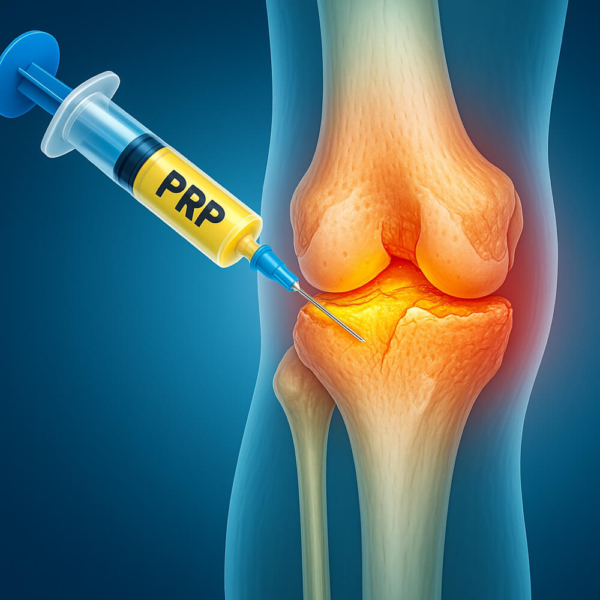Bone-on-Bone Solutions: How PRP in Las Vegas Could Extend the Life of Your Joint
“I was told knee replacement is my only option.” If you’ve heard these words from a doctor after being diagnosed with bone-on-bone knee arthritis, you’re not alone. Many Las Vegas residents with advanced knee arthritis feel they’re facing an inevitable choice between living with pain or undergoing major surgery.
But what if there was another path worth exploring?
What “Bone-on-Bone” Really Means
When doctors describe your knee as “bone-on-bone,” they’re telling you that the protective cartilage cushioning your joint has significantly worn down. This cartilage normally acts like a shock absorber between the bones, allowing smooth, pain-free movement. When it deteriorates, your bones can literally rub against each other during movement, causing inflammation, pain, and that characteristic grinding sensation many patients describe.
Think of it like driving a car where the shock absorbers are completely worn out – every bump in the road is felt dramatically, and the ride becomes increasingly uncomfortable and potentially damaging.

Considering Your Treatment Options
When managing bone-on-bone knee arthritis, multiple treatment approaches may be considered:
Conservative Approaches:
- Physical therapy: Strengthens supporting muscles and improves function
- Bracing: Provides support and may improve alignment
- Weight management: Reduces load on the joint
- Anti-inflammatory medications: Provide temporary symptom relief
Injection Options:
- Cortisone: Provides quick, short-term pain relief (2-4 weeks), though repeated use may have diminishing returns
- Hyaluronic acid: Acts as a joint lubricant, typically lasting 3-6 months
- Platelet-Rich Plasma: May modulate inflammation and support your own body’s natural tissue healing processes
Surgical Options:
- Arthroscopic procedures: Limited benefit for advanced arthritis
- Partial knee replacement: For arthritis limited to one compartment
- Total knee replacement: The definitive treatment for end-stage arthritis
Our team of orthopedic specialists can help determine which approach best suits your specific condition, lifestyle needs, and goals.
If you’re dealing with bone-on-bone pain, you know that over-the-counter pain medications only mask symptoms temporarily. Cortisone shots, while providing relief, can actually accelerate cartilage breakdown with repeated use. And while staying active is important, the pain often makes movement difficult.

Why Patients Seek Alternatives to Knee Replacement
Even with advanced arthritis, many patients have compelling reasons to postpone surgery:
- Recovery concerns: A full knee replacement typically requires weeks of limited mobility and months of rehabilitation
- Lifestyle disruption: Surgery means pressing pause on work, hobbies, and family responsibilities
- Desire to stay active: Many Las Vegas residents want to maintain their current lifestyle without a lengthy surgical interruption
- Concerns about artificial joints: Some worry about the lifespan of prosthetic joints or potential complications
What Is PRP Therapy?
Platelet-Rich Plasma (PRP) therapy represents a biological approach to managing knee arthritis. Rather than simply masking symptoms or replacing the joint entirely, PRP works with your body’s natural healing mechanisms.
Here’s how it works:
- A small sample of your blood is drawn (similar to a routine blood test)
- The blood is processed in a centrifuge to concentrate the platelets
- This concentrated solution is then precisely injected into your knee joint
What makes platelets special is that they contain powerful growth factors and signaling proteins that help regulate inflammation and support tissue healing. When concentrated and delivered directly to your damaged knee joint, these platelets release these healing factors where they’re needed most.
In fact, at Ortho Las Vegas, we regularly use PRP in conjunction with surgical interventions as a way to potentially optimize patient outcomes and support your body’s natural healing process.
Why PRP Shows Promise for Bone-on-Bone Conditions
While no non-surgical treatment can reverse severe arthritis completely, research suggests PRP may help in several important ways:
- Reduces inflammation: PRP can help calm the inflammatory response that causes much of the pain in arthritic joints
- Improves function: Many patients report improved mobility and ability to perform daily activities
- Provides pain relief: Studies show significant pain reduction in many patients with knee arthritis
- Potentially slows progression: Some research suggests PRP may help slow cartilage breakdown, though more long-term studies are needed
We explain it this way at our office: “Think of PRP not as a way to regrow cartilage, but as a way to create a healthier environment in the joint. By reducing inflammation and supporting the remaining tissues, many patients experience meaningful improvement even with advanced arthritis.”

What Research Shows About PRP for Severe Knee Arthritis
Multiple clinical studies have examined the effects of PRP on knee arthritis:
- A 2021 systematic review published in the Journal of Pain Research found that PRP injections provided significant pain reduction and functional improvement for patients with knee osteoarthritis (1)
- Research in the American Journal of Sports Medicine showed that many patients experience benefits lasting 6-12 months after treatment, with some seeing longer results
- Evidence suggests that a series of injections often produces better results than a single treatment
It’s important to set realistic expectations: PRP isn’t a permanent “cure” for arthritis. Rather, it’s a management strategy that may help extend the life of your natural joint and delay the need for more invasive procedures.
Who Makes a Good Candidate for PRP in Las Vegas?
PRP therapy may be worth considering if you:
- Have moderate to severe knee arthritis but want to stay active
- Are looking to delay knee replacement surgery
- Have tried conventional treatments like cortisone injections or pain medications with limited success
- Are willing to participate in a comprehensive treatment approach
- Don’t have active infections or certain blood disorders
- Have realistic expectations about outcomes
The ideal candidate understands that PRP is part of a broader strategy for joint health that might include weight management, appropriate exercise, and other supportive measures.
Is PRP Right For You? Key Factors To Consider
While many patients with knee arthritis may benefit from PRP, certain factors can help predict treatment success:
Favorable factors that may predict better response:
- Mild to moderate arthritis (some joint space remaining on X-rays)
- Age under 65
- Active lifestyle with good muscle strength
- No significant knee malalignment
- Realistic expectations about outcomes
Signs that PRP may not be your best option:
- Complete loss of joint space with extensive bone spurs
- Significant knee instability or malalignment
- Multiple previous knee surgeries
- Expectations of complete pain elimination
Measuring Success: A successful PRP treatment typically results in:
- 50-70% reduction in pain levels
- Improved ability to perform daily activities
- Reduced reliance on pain medications
- Increased activity tolerance
- Benefits lasting 6 months or longer
During your consultation, we’ll thoroughly evaluate your condition and discuss whether PRP aligns with your specific needs and goals.
The PRP Procedure at Ortho Las Vegas: What to Expect
If you’re considering PRP therapy for bone-on-bone knee arthritis, here’s what you can expect at Ortho Las Vegas:
Step 1: Comprehensive Consultation
Your journey begins with a thorough evaluation with Dr. McGee, who will:
- Review your medical history and previous treatments
- Perform a physical examination of your knee
- Review relevant imaging (X-rays, MRI if available)
- Discuss whether PRP is appropriate for your specific condition
- Answer all your questions about the procedure and expected outcomes
Step 2: The PRP Procedure
The procedure itself is straightforward and performed right in our office:
- A small amount of blood is drawn from your arm
- The blood is processed in a specialized centrifuge to concentrate the platelets
- The area around your knee is cleaned and numbed
- Using precision guidance, the PRP is injected into the specific areas of your knee joint
- The entire process typically takes less than an hour
Step 3: Recovery and After-Care
One of the advantages of PRP therapy is the minimal downtime:
- Most patients can return to regular daily activities within 24-48 hours
- We recommend avoiding strenuous exercise for a short period
- Some patients experience mild soreness that resolves quickly
- A customized plan for appropriate activity and joint protection will be provided
Step 4: Follow-Up and Monitoring
Your treatment doesn’t end with the injection:
- Follow-up appointments allow us to monitor your progress
- Additional treatments may be recommended based on your response
- Complementary strategies for joint health will be discussed
- Long-term planning for your knee health continues
Is PRP Right for Your Bone-on-Bone Knee Pain?
If you’re dealing with advanced knee arthritis and want to explore options beyond pain medication or immediate surgery, PRP therapy may be worth considering. It’s important to have a detailed conversation with a qualified orthopedic specialist who can assess your specific condition and help determine if PRP is appropriate for you.
PRP represents a low-risk biological approach that has helped many Las Vegas-area patients improve their quality of life and stay active despite significant arthritis. While it can’t “cure” bone-on-bone arthritis, it offers a meaningful option in the spectrum between basic pain management and joint replacement surgery.
Understanding PRP Risks and Limitations
Like any medical procedure, PRP therapy has potential risks and limitations to consider:
Potential Side Effects:
- Post-injection soreness or pain (common, typically resolves in 2-3 days)
- Temporary inflammation or swelling
- Small risk of infection (less than 1%)
- Rare allergic reactions
Important Limitations:
- Results vary significantly between patients
- Multiple injections may be needed for optimal results
- Not all patients experience significant improvement
- Advanced bone-on-bone arthritis may see more modest benefits
Patients with certain blood disorders, active infections, or cancer should not undergo PRP therapy. Always discuss your complete medical history with your physician before proceeding.
Financial Considerations
PRP therapy is generally not covered by many insurance companies for bone on bone knee arthritis treatment:
- Most insurance plans, including Medicare, do not currently cover PRP for knee arthritis
- Treatment protocols may involve 1-3 injections; some patients repeat as needed
- Some flexible spending accounts (FSAs) or health savings accounts (HSAs) may be used
- Our office can provide detailed cost information and payment options during your consultation
If you’re ready to explore whether PRP could help manage your knee arthritis, schedule a consultation at Ortho Las Vegas today. Dr. McGee and our team will take the time to understand your unique situation and help you determine the best path forward for your joint health.
About the Author
Dr. Roddy McGee is a fellowship-trained orthopedic surgeon specializing in sports medicine and joint preservation. As a Las Vegas native and former college athlete, he brings both local understanding and sports experience to his orthobiologic treatments. After completing his medical training and prestigious sports medicine fellowship at the American Sports Medicine Institute, Dr. McGee now serves as team physician for several athletic programs including College of Southern Nevada and Bishop Gorman High School.
He is dedicated to providing advanced joint preservation options for patients seeking alternatives between conservative care and surgery. Dr. McGee combines his expertise in both surgical and non-surgical approaches to deliver personalized care for patients with knee arthritis and other joint conditions.

Sources
- “Intra-Articular Platelet-Rich Plasma Injections in Knee Osteoarthritis: A Review of Their Current Molecular Mechanisms of Action and Their Degree of Efficacy” https://pmc.ncbi.nlm.nih.gov/articles/PMC8836227/#:~:text=Another%20review%20of%20the%20literature,12%20months%20following%20PRP%20injection.
- “Are multiple platelet-rich plasma injections useful for treatment of chronic patellar tendinopathy in athletes? a prospective study” https://pubmed.ncbi.nlm.nih.gov/24519184/

